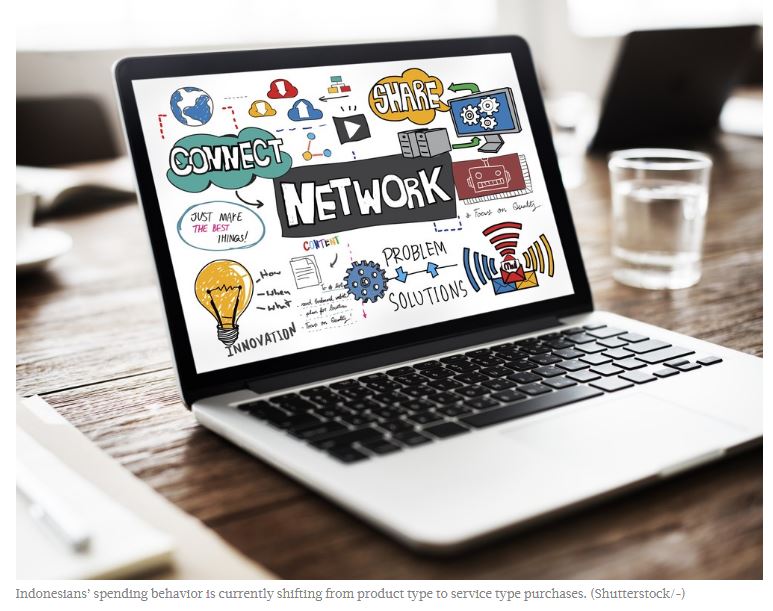Digital technology and Indonesia’s consumer megatrends
Fast-growing digital technology and connectivity are reshaping consumer behavior.
According to the latest report by London-based strategic market research company Euromonitor International, which breaks down consumer trends and spending in Indonesia, digital technology, connectivity and social media play an important role in how consumers make decisions.
Euromonitor groups the products and services into five categories that Indonesian consumers spent their money on last year (see the table). From these five categories, they spend the most on food, beverages and tobacco (34 percent).
But the research company notes the two other categories — consumer food service and travel — which are in second and third position, respectively, have posted greater growth over the last five years, compared to other categories.
Euromonitor research manager Adhitya Nugroho noted that Indonesians’ spending behavior was currently shifting from product type to service type purchases, adding that the increased spending on travel and consumer food services was strongly influenced by social media and the emergence of a huge number of millennials who tend to spend more on traveling.

Graphic of five categories of products and services for which the Indonesian consumers spent in 2017. (Euromonitor/File)
Nineteen percent went to food services last year, while 14 percent were spent on travel, which was also recorded as the sector with the fastest growth in the last five years, while consumer food service was the second fastest.
“Social media actually influences them to decide where to travel […] It is also important in terms of how they show off [their travel experiences] to their friends,” Adhitya said at the Indonesia Euromonitor International Conference on Tuesday.
Indonesia has a demographic bonus with a high number of millennials — roughly around 60 million people — and it also contributes to the rise of spending on travel. “This segment is more interested in traveling and they are more adventurous than the previous generation. When they have extra money or disposable income, they will spend more on travel,” he added.
In fact, travel blogs have also inspired people to travel more. The presence of hotel and airline ticketing platforms like Traveloka also make traveling easier. Many platforms also offer discounts that encourage people to travel.
Social media also plays a role in driving people to spend money on food services as more, especially millennials, are looking for exciting culinary experiences. They will go on social media to find recommendations on unique food experiences.

Euromonitor International research manager Adhitya Nugroho speaks when delivering a report on Indonesia consumer behavior at the Euromonitor International conference in Jakarta on Sept. 25. (JP/Riza Roidila Mufti)
Euromonitor also notes that cashless payments are one of the important developments that help people to spend. Adhitya said cashless payments were becoming more and more popular since the government kicked off the cashless society campaign last year.
“Maybe cashless payments do not encourage people to spend more, but it is actually creating a unique convenience. If cashless payments are convenient, it will influence consumers to purchase things in the long run.”
Based on Euromonitor’s digital consumer data, 75 percent of online food service purchases have been made on smartphones. Digital payments are expected to grow as the number of people owning smartphones is on the rise.
Meanwhile, a Euromonitor consulting team led by Dhea Sutanto said there were three relevant megatrends that shaped Indonesian consumers’ behavior today and they would define consumer behavior in the future – the connected consumer, premiumization and experience, adding that the three were important insights for business players to formulate their business strategies to attract consumers.
Connected consumers are those who are connected to the internet and are able to access digital experiences, interactions and content.
Euromononitor International estimates that 58 percent of households own smartphones in 2018, and this figure will grow to 78 percent by 2020.
Based on its global consumer trend survey on mobile phone activity in Indonesia, 84 percent of people with mobile phones browse the internet and 65 percent visit social networking sites every day.
Meanwhile, 13 percent use mobile phones to book or order ride-sharing services and 11 percent order food and drink online, while 10 percent buy items or services through their mobile phone every day.
“Connectivity has changed almost all aspects of the consumers’ life. Hence, understanding how consumers behave in their lifestyle choices is important for successful marketing strategies,” said Dhea, adding that the number of connected consumers would increase in the future.
Meanwhile, “premiumization” means that nowadays consumers are important to premium brands. This is driven by several factors, such as the rise of a new affluent class and the surge in lifestyle spending. Premiumization drives business players to offer better consumer services, even though they are not a branded product or service.
“With the rise of a younger population with mobile connectivity, consumers are also looking for a variety of experiences. It drives many brands to offer different experiences and services to their consumers. In accommodation, for example, several hotels have offered capsule pod-type rooms, something that people have never experienced before,” Dhea said. (bbn)
Source: http://www.thejakartapost.com/news/2018/09/28/digital-technology-and-indonesias-consumer-megatrends.html


 English
English




